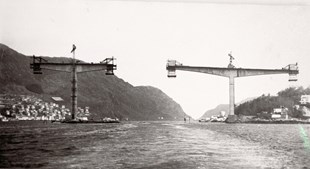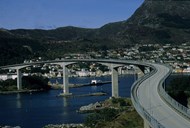The dream of a bridge across the strait of Måløysundet
As early as in 1918, the idea of connecting Måløy to the mainland was brought up. In the master plan for Måløy, worked out by the Bergen architect Schumann Olsen, a drawing of a "Bridge connection between Kulen and Moldøen" was included. In the railway plan for the county of Sogn og Fjordane from 1920, on the other hand, a railway bridge to Måløy was not mentioned. It was intimated that a railway line would be built to Deknepollen. The depression in the 1930s with many bankruptcies in the fishing trade effectively stopped all plans of a bridge across the strait. The railway plans for Sogn og Fjordane were not realized either. Only in 1948, when a new road was built to Deknepollen, was the issue of a bridge across the strait brought up again. In 1949, the board of aldermen of the Sør-Vågsøy municipality sent a statement to the Nordfjord communication committee on the need for an "unbroken connection between the island of Vågsøya and the mainland". The car-ferry traffic was started up in 1948.

Incredibly rich herring fisheries with new optimism
The 1950s were an economic boom period for Måløy with incredibly rich herring fisheries. These fisheries caused growth and prosperity, and people now demanded an adequate connection to the mainland. The issue of a connection to the mainland was a recurrent item on the agendas of the local council in the 1950s. The mayor in 1955, Marius Larsen, penned the basic principles for the further work with the bridge project: It would be financed by toll money, under the administration of an independent, responsible company. The construction would be financed with loans, and the municipality would guarantee for these loans. This would be a heavy economic burden for a municipality with only 3000 inhabitants. The Public Roads Administration in the county was also interested in a bridge project. Its chief administrator at that time, Egil Abrahamsen (1956-1970), became an important supporter of the bridge project.
Bridge or tunnel?
In the 1960s, several attempts were made to dig tunnels under water, and the Public Roads Administration surveyed the terrain in the strait. The idea of a tunnel was far from unrealistic, and many people went in for this alternative. The technology was there, and through its hydroelectric development, Norway had a long experience in constructing tunnels under water. The motorboat pilot Karl Lofnes, on the other hand, was a keen advocate for the bridge alternative. He started a private bridge company, and he also took the initiative to establish a non-political party "Vågsøy upolitiske samlingsliste" (the bridge list) which in 1963 took part in the local elections. They got three representatives into the municipal council, and held a high political profile with letters to the newspapers and even had its own bridge planner. The Public Roads Administration eventually went in for the bridge alternative, when they found out that the expenses for building a bridge or tunnel would be just about the same.
Great willingness to finance the bridge
The Public Roads Administration calculated the economic aspect of the project to 17 million kroner in 1971. The bridge would have to be partially financed by toll money. The reason was that before the road project Eide-Barmsund-Almenning was completed, it was hard to get any allocations for the project. Normally, bridge companies would have to cover 2/3 of the expenses, whereas 1/3 would be covered by the state. In the case of the Måløy, it was the other way around.
In 1966, the municipal authorities sent out an invitation for subscription of shares in the bridge company "Måløybrua A/S" (Ltd.). The share capital was 600 000 kroner, and each share cost 100 kroner. Leif Iversen was chosen to be the manager of the toll company. He was a former mayor of Sør-Vågsøy.
Before the municipalities were united in 1964, Nord-Vågsøy had allocated half a million kroner to the bridge project. Vågsøy allocated about one million kroner, and, in addition, the Vågsøy municipality bought 342 shares and guaranteed for loans that the "Måløybrua A/S"had taken up.


A serious set-back
On 15 November 1967, the county council decided unanimously that the plans for the Måløy Bridge and a new year-round road across the mountain pass of Strynefjellet had to be connected. The road projects had to be given top priority in terms of major road construction projects in the county in the coming 15 years. On 10 December 1968, the Storting decided that the bridge project was to be a part of the construction of highway 15 from Otta to Måløy.
However, it turned out that the cost estimate had probably been set too low. Two similar bridge projects in northern Norway had become twice as expensive after the invitation to tenders. Consequently, a new cost estimate for the Måløy Bridge was set to 34 million kroner, instead of 17 million. The submitted tender was 34 million kroner. The Public Roads Administration demanded that the toll company would have to raise half this sum. This led to many sleepless nights for Leif Iversen in the toll company, but they managed to get new loans through hard work. The project was after all considered to be solid and future-oriented. The final expenses for the bridge actually amounted to 32 million kroner.
The car frequency surpassed the prognoses
The bridge opened for traffic in December 1973. In relation to the population and the traffic prognoses, this was in fact a daring project, but it soon turned out that the traffic shattered all prognoses. 188 000 cars were registered the first year, 78 000 more than projected. Eight years later, the private car traffic had been projected to 180 000 cars, whereas it actually surpassed 390 000 cars. The toll rate for a private car was 12 kroner, and for a semi-trailer it was 48 kroner. For a child it cost one krone to cross the bridge and two for an adult person. The collection of toll money was terminated on 1 August 1984, and the bridge company was dissolved in April 1986.








